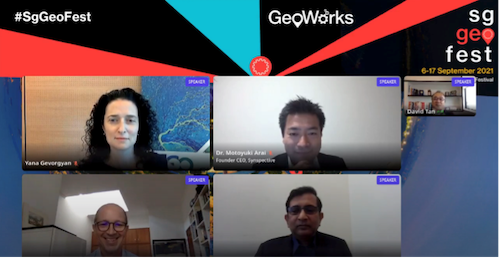
|
Home >
Settings >
Archives >
October 2021 >
SgGeoFest 2021: Panel on Catalysts for Earth Observation
SgGeoFest 2021: Panel on Catalysts for Earth Observation

(Clockwise from top): Dr Motoyuki Arai (Synspective), Abhay Swarup Mittal (EOfactory), Clinton Libbey (Kumi Analytics) and Yana Gevorgyan (Group on Earth Observations Secretariat).

Space, the “heavenly frontier”, said David Tan from the Office of Space Technology & Industry (OSTIn), EDB, is no longer “the domain for the rich, the powerful and the famous”.
“The world indeed is already at the dawn of what I call the new space economy, ready at the edge or even perhaps at the start of a lift-off. In fact, Morgan Stanley published that the estimated 350 US billion global space industry could surge to over 1 trillion by 2040 and at least 60 percent of them are commercial,” he said.
Mr Tan was moderating a panel on Catalysts for Earth Observation at the recent Singapore Geospatial Festival 2021. “Launch prices are falling. And because technologies are also pushing, technology giants are driving demands and this makes low-cost small satellite constellations to be cheaper, better and outperform the bigger ones.”
Panellists at the session – Abhay Swarup Mittal from EOfactory, Yana Gevorgyan from the Group on Earth Observations Secretariat, Clinton Libbey from Kumi Analytics and Dr Motoyuki Arai from Synspective – shared insights on the potential catalysts or partnerships and collaboration that can ignite new business models.
When asked what commercial satellite companies can do to foster the creation and accessibility of good training data sets, Mr Mittal from EOfactory, a platform that provides earth observation insights, said that a lot of commercial satellite companies are “moving up the value chain to deliver analytics” and holding on to their data. However, by holding on to their data, it makes it difficult for others to create training data sets and this will not serve the entire market.
AI, Mr Mittal said, is specific to imagery, resolution, the atmospheric condition and the way it’s processed. “The same AI model may not work on the similar type of image in a different location, in different environment. The building structures are different. So if you were to do certain AI work, you need to continuously train and if you are not trained on a specific sensor, you will not be able deliver.”
Mr Mittal added that there needs to be trust between data providers and analytical companies. “If there is no trust, it will not work because people still believe that they must hold on to the data because it is very much owned by them.”
Speakers also had discussions on the role of government and commercial players for earth observation.
View recording: https://youtu.be/14wrWNMbkec